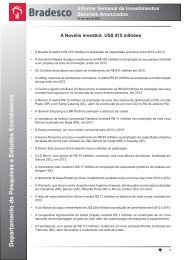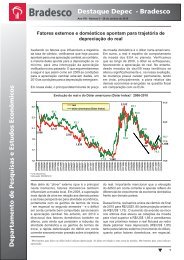Depec-Bradesco Economic Highlights - Economia em Dia
Depec-Bradesco Economic Highlights - Economia em Dia
Depec-Bradesco Economic Highlights - Economia em Dia
Create successful ePaper yourself
Turn your PDF publications into a flip-book with our unique Google optimized e-Paper software.
<strong>Depec</strong>-Bradeso <strong>Economic</strong> <strong>Highlights</strong><br />
If the pace of economic activity over the next few months<br />
is still incompatible with the convergence of the infl ation<br />
cores onto the center of the target, another signifi cant<br />
question that the Central Bank will have to deal with will<br />
relate to the instruments to be utilized in order to bring<br />
about convergence. An important part of the diagnosis<br />
of the current deceleration of economic activity is due<br />
to the interpretation that the increase in imports and the<br />
“weakness” of exports of manufactured goods is acting<br />
like a brake upon GDP growth, channeling overseas<br />
the excess domestic d<strong>em</strong>and 2 . This diagnosis, coupled<br />
with the unusual circumstances in the manner which<br />
monetary policy is being impl<strong>em</strong>ented in the world mean<br />
that the traditional usage of interest rates by the Central<br />
Bank may be less intense in the present monetary<br />
tightening cycle, in case a greater-than-presentlyexpected<br />
increase is required. This is because of the<br />
fact that the increase in interest rates has an impact<br />
on the FX rate, making it appreciate even more during<br />
a time of excess global liquidity.<br />
8,0%<br />
6,9%<br />
7,0%<br />
6,0% 5,8%<br />
5,0%<br />
4,0%<br />
3,0%<br />
2,0%<br />
1,0%<br />
0,0%<br />
-1,0%<br />
-2,0%<br />
4,1% 3,8%<br />
3,4%<br />
2,3% 2,0% 1,8%1,6% 1,5% 1,4% 1,3% 1,2%<br />
1,0% 1,0%<br />
If the Brazilian Central Bank is one of the only ones to<br />
excessively raise interest rates in this global context in<br />
which the interest rates of the developed countries are<br />
extr<strong>em</strong>ely low – and operating by means of quantitative<br />
mechanisms – and the <strong>em</strong>erging economies are making<br />
greater use of macro-prudential measures than of<br />
interest rates, then Brazil’s FX could perhaps register<br />
an excessive appreciation. Such an appreciation in<br />
the real would aggravate the economy’s external<br />
competitiveness 3 . The signs given off by the present<br />
administration suggest that this is an important th<strong>em</strong>e<br />
for the economic policymakers and, therefore, the side<br />
effects of raising interest rates cannot be overlooked<br />
in this economic policy framework. As a result, any<br />
aggressive action in terms of raising interest rates in this<br />
phase, in addition to not being justifi ed on account of the<br />
slowing down in economic activity, does not se<strong>em</strong> very<br />
likely in our opinion, as it would aggravate the external<br />
leak and intensify the deceleration in economic activity<br />
that is already underway.<br />
0,4% 0,2% 0,2% 0,2%<br />
Venezuela<br />
Serbia<br />
Romania<br />
Estonia<br />
Greece<br />
Uruguay<br />
Indonesia<br />
U K<br />
Portugal<br />
Thailand<br />
Singapore<br />
Malta<br />
Brazil<br />
Spain<br />
Belgium<br />
Colombia<br />
Slovakia<br />
Poland<br />
India<br />
Korea<br />
Lux<strong>em</strong>burg<br />
Hungary<br />
Finland<br />
China<br />
Austria<br />
Mexico<br />
South Africa<br />
Euro Zone<br />
Canada<br />
Italy<br />
Slovenia<br />
France<br />
Holland<br />
Germany<br />
Australia<br />
Cyprus<br />
Sweden<br />
Ireland<br />
Czech Republic<br />
USA<br />
Peru<br />
Philippines<br />
Chile<br />
Therefore, in our opinion, the Copom will raise interest<br />
rates by 50 bps at this meeting and will wait to see the<br />
results of this monetary policy action combined with<br />
the macro-prudential, fi scal and para-fi scal measures.<br />
In addition to being effective, it se<strong>em</strong>s to us that these<br />
actions will be come on top of a deceleration that is<br />
already underway in the factor that has been the main<br />
vector of infl ationary acceleration over the last few<br />
months, namely the labor market. As a result of this,<br />
in our opinion there is no justifi cation for any more<br />
-0,3%<br />
-1,0%<br />
Comparison<br />
between the<br />
12-month infl ation<br />
differential<br />
(headline) and each<br />
country’s infl ation<br />
target<br />
Source: CEIC<br />
Produced by: BRADESCO<br />
pronounced acceleration in the intensity or total size<br />
of the interest rate cycle, at the very moment in which<br />
the vectors that govern infl ation are pointing to a much<br />
more favorable outlook for the cores.<br />
Summing up, we are not underestimating the infl ationary<br />
phenomenon and we recognize that inflation is a<br />
challenge that faces Brazil as well as dozens of other<br />
countries. However, the already clear endogenous<br />
or induced signs of deceleration lead us to believe<br />
2 Nor can we fail to take into account that part of the deceleration that is already being seen in the economy may be the result of the increase in interest<br />
rates that the Central Bank impl<strong>em</strong>ented during the fi rst half of last year, the <strong>em</strong>pirical results of which were expected to be seen at the end of that year.<br />
Although the transmission channels of that interest rate increase are not clear – after all, interest rates on credit continued to drop, the level of confi dence<br />
of businessmen and consumers was not affected – it is possible that the appreciation in the real FX rate that followed and households’ consumption and<br />
savings decisions have meant that the increase in interest rates was transmitted to economic activity. Incidentally, the interest rate that matters to the<br />
economy is the real swap rate and this has been increasing since the middle of 2009 by roughly 2.0 p.p. during the period, which leads us to believe that,<br />
in effect, part of the economic activity adjustment may have come through this channel.<br />
3 This appreciation would certainly help to reduce infl ation, and the increase in interest rates would eventually lead to a decrease in the country’s external<br />
defi cit at a later time, on account of the moderating effect on domestic d<strong>em</strong>and. However, initially the effect would be to aggravate the loss of competitiveness.<br />
DEPEC<br />
4




